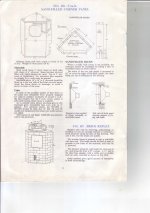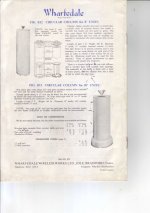See...Hey no one has ‘ yelled ‘ at me for a whole day.
is something wrong?
lol
Be careful what you wish for!
Concrete has been done before.
Or others have used Plywood/ MDF
and use normal Window Braces.
People have also added braces to thin wall
production speakers. been done before.
Does it make the speaker have mind blowing
magical sound? Not really
The driver is what it is.
It has been done before, though
Most common mods would be adding
1 or 2 window braces.
Then Adding common used absorption materials.
wool/ felt lining or poly filling.
If the production unit is found to have none
to very minimal absorption material.
Or others have used Plywood/ MDF
and use normal Window Braces.
People have also added braces to thin wall
production speakers. been done before.
Does it make the speaker have mind blowing
magical sound? Not really
The driver is what it is.
It has been done before, though
Most common mods would be adding
1 or 2 window braces.
Then Adding common used absorption materials.
wool/ felt lining or poly filling.
If the production unit is found to have none
to very minimal absorption material.
I don’t know of others here, but I’ve had the pleasure to compare the virtually exact same speaker in special damped concrete vs. ‘ordinary’ MDF enclosures back a few decades ago. It really, really sounded different, while (simple level vs freq) measurements showed the same response. I wish I had ARTA, a sound card and a decent PC then…
...the pleasure to compare the virtually exact same speaker …
We did MDF (¾") vrs BB (18mm). Thats when it became clear that we should use quality plywood.
dave
If I made two speakers that measured the same, but sounded different it would drive me NUTS not knowing WHY they sounded different.
well not everything is quantifiable yet in acousitics.
so it could just well happen that way.
To name just a few:If I made two speakers that measured the same, but sounded different it would drive me NUTS not knowing WHY they sounded different.
Cartridge misalignment
Wiring
Amp inconsistencies (tolerances, biasing etc.)
Room acoustics
Crossover component tolerances
I'm sure the followers of this thread will be able to add quite a few other reasons for the sound to be slightly different.
In my case, my room acoustics suck. Ive asked my wife if we could move to a more acoustic friendly house but I was threatened with moving alone... hmmmmm
You seem convinced of that.not everything is quantifiable yet in acousitics.
You seem convinced of that.
well of course. It’s not a perfect science.
right?
we have made tons of strides , but there is still a lot which can’t be quantified.
I mean we are still using voice coils to produce sound.
it’s not the most advanced science.
but it’s got way way better. From the days that people just slapped together a box and put drivers in it. and had no clue of cabinet resonances , on and off axis measurements etc.
it’s not the most advanced science.
but it’s got way way better. From the days that people just slapped together a box and put drivers in it. and had no clue of cabinet resonances , on and off axis measurements etc.
From the days that people just slapped together a box and put drivers in it. and had no clue of cabinet resonances
What, like in the 1950s and 60s?
Attachments
What, like in the 1950s and 60s?
ha yeah. That wasn’t what was in peoples homes in the 50’s and 60’s.
more like those all in one consoles like furniture . If anyone could even afford them.
That wasn’t what was in peoples homes in the 50’s and 60’s.
Were you around in the 60s, enjoying the flower power, man?
They were to be found in the homes of diehard Hi-Fi enthusiasts - I know!
One guy even built his music room house extension around a pair of those brick enclosures - they were the first thing installed after the foundations.
Oh, and there was the concrete column! 😉
Attachments
No but I was in the 70’s.
and my uncle and some of my dads friends had those huge console furniture stereos from the 50’s and 60’s still in their homes.
i never saw a proper stereo until the late 70’s
and my uncle and some of my dads friends had those huge console furniture stereos from the 50’s and 60’s still in their homes.
i never saw a proper stereo until the late 70’s
..was just trying to help.well of course. It’s not a perfect science.
right?
we have made tons of strides , but there is still a lot which can’t be quantified.
..was just trying to help.
what do you mean?
i got lost. Ha
seriously.
Understood.ha yeah. That wasn’t what was in peoples homes in the 50’s and 60’s.
more like those all in one consoles like furniture . If anyone could even afford them.
Affordable mass produced designs vary with quality in the past and present
Your claiming in the past they did not know about panel resonance.
When a early example clearly shows they did. And use same methods then and today to lower or raise resonance.
If a manufacturer decides to use or not use methods to reduce panel resonance.
It does not change the timeline of well established engineering knowledge.
Basing assumptions on low to Medium cost examples. Is silly.
Looking at horrible plastic portable bluetooth speakers today. Might as well assume modern audio knowledge is absolutely nothing LOL.
Last edited by a moderator:
Our science, while seeming quite advanced has a LONG way we can go.
Audio science, which has gotten little really, really serious research dollars since the days of Olson, and conservative loudspeaker makers puts audio science behind many others.
as affordable tools come down to the masses we continue to learn more & more.
I was amazed to read today that 39 (?) backyard physicists have achieved fusion…
dave
Audio science, which has gotten little really, really serious research dollars since the days of Olson, and conservative loudspeaker makers puts audio science behind many others.
as affordable tools come down to the masses we continue to learn more & more.
I was amazed to read today that 39 (?) backyard physicists have achieved fusion…
dave
Last edited:
- Home
- Loudspeakers
- Multi-Way
- What do I need to measure speaker cab resonances?

